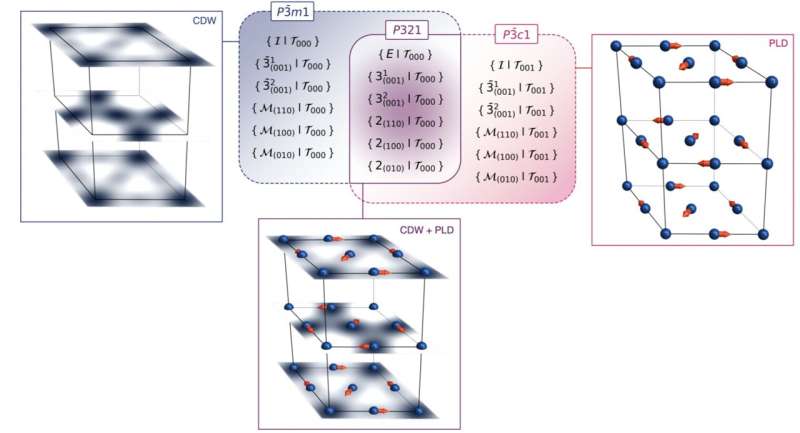
November 14, 2024 by Ingrid Fadelli , Phys.org
Collected at: https://phys.org/news/2024-11-physicists-key-mechanism-chiral-density.html
Chirality is a property of some molecules, subatomic particles, living organisms and other physical or biological systems. This property entails a lack of mirror symmetry in these systems’ underlying structures.
Researchers at Pohang University of Science and Technology, Argonne National Laboratory and other institutes recently carried out a study investigating the origins of chirality in the transition-metal dichalcogenide 1T phase titanium diselenide (1T-TiSe2). Their paper, published in Nature Physics, outlines a key mechanism that contributes to the formation of a chiral charge density wave in this material.
“TiSe2 is a material that has been known since 1976 and extensively studied since then,” B. J. Kim, senior author of the paper, told Phys.org. “In particular, its crystal structure has been studied in detail and revisited many times, and all previous studies only found consistency with the known structural model.
“If the crystal structure was correct, however, it ruled out some of the very interesting electronic properties that become permitted by the absence of certain symmetries in the crystal structure—the Neumann’s principle requires the crystal and the lattice structures to have the same symmetry.”
Recent studies gathered extensive evidence suggesting that the part of the structure of TiSe2 related to its electronic properties (i.e., its electronic sector) exhibits chirality. Specifically, they found that this electronic sector lacked elements with mirror-like symmetry, a finding that is inconsistent with the material’s known crystal structure.
“We were very much intrigued by this inconsistency pointing to a possible violation of a fundamental principle,” said Kim. “We believed either the chiral charge density waves or the crystal structure had to be wrong, and this was the starting point of our study. Our goal was to resolve the inconsistency between the electronic and the lattice sectors.”
To resolve the previously reported discrepancy between the electronic and lattice configuration of TiSe2, the researchers first conducted a theoretical symmetry analysis. This analysis was aimed at systematically checking how the material’s space group symmetry changed under specific lattice distortions and in response to the formation of charge density waves.
The team’s findings revealed that lattice distortion and charge density waves in TiSe2 resulted in different space group symmetries. Interestingly, they also showed that these space group symmetries induced further lattice distortions.
“We then used Raman scattering and inelastic X-ray scattering to look for signatures of these additional lattice distortions,” explained Kim.
“We knew that the lattice distortion was going to be very minute and subtle, so instead of using X-ray/neutron diffraction that measures the equilibrium position of atoms, we tracked how lattice vibration modes (or phonons) respond to the formation of charge density waves, from which one can also infer the change in the symmetry.”
This recent study gathered interesting new insights about the possible origin of the chiral charge density wave previously observed in TiSe2. The theory-based hypothesis proposed by the researchers was already validated experimentally using optical and spectroscopic techniques, but it could be further tested in future experiments.
“Chirality is a phenomenon not particular to this material but ubiquitous in nature and can be found in many different settings ranging from subatomic particles, molecules to living organisms,” added Kim.
“The microscopic mechanisms whereby chirality arises remain unknown for many cases. I think the most notable achievement of our study is that we found a mechanism for chirality for the first time.”
More information: Kwangrae Kim et al, Origin of the chiral charge density wave in transition-metal dichalcogenide, Nature Physics (2024). DOI: 10.1038/s41567-024-02668-w
Journal information: Nature Physics

Leave a Reply